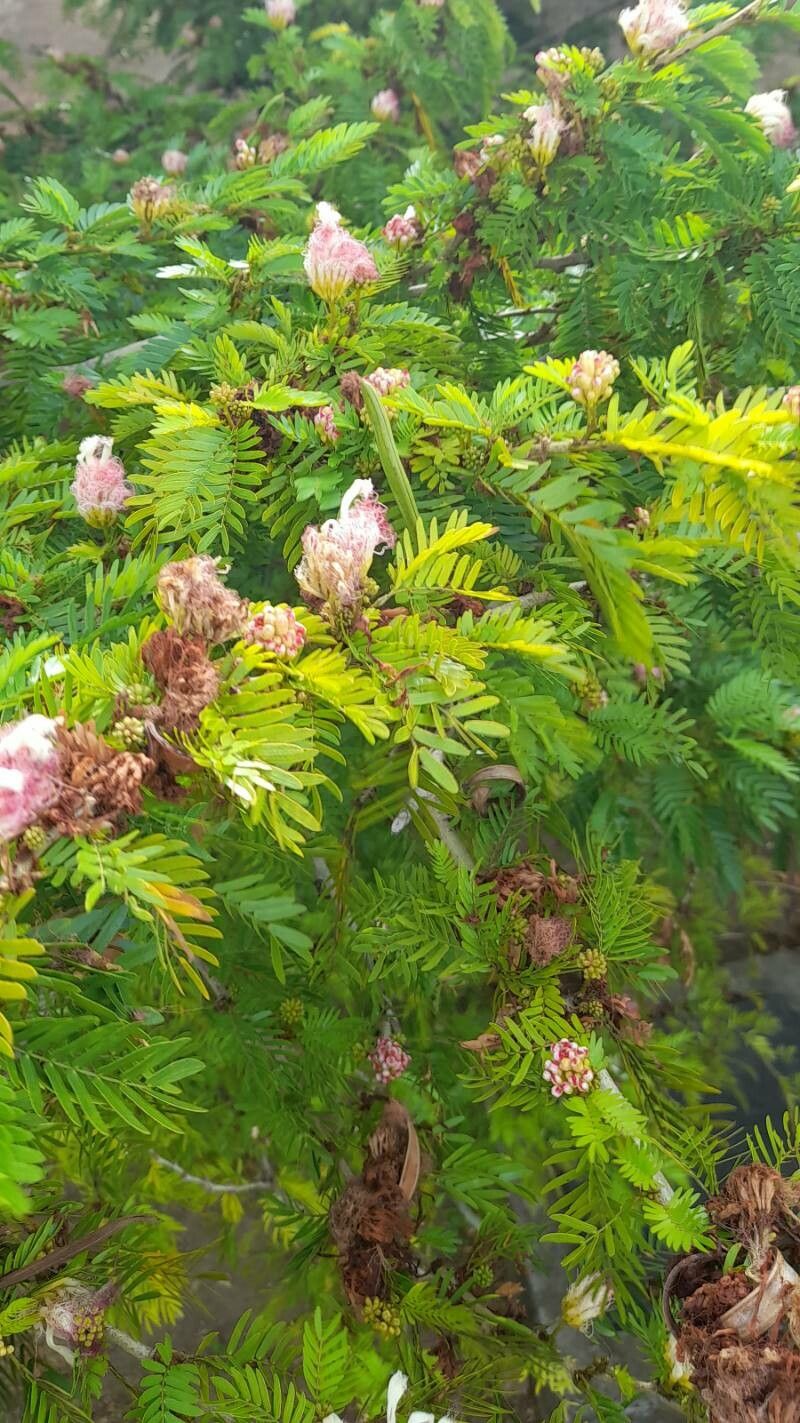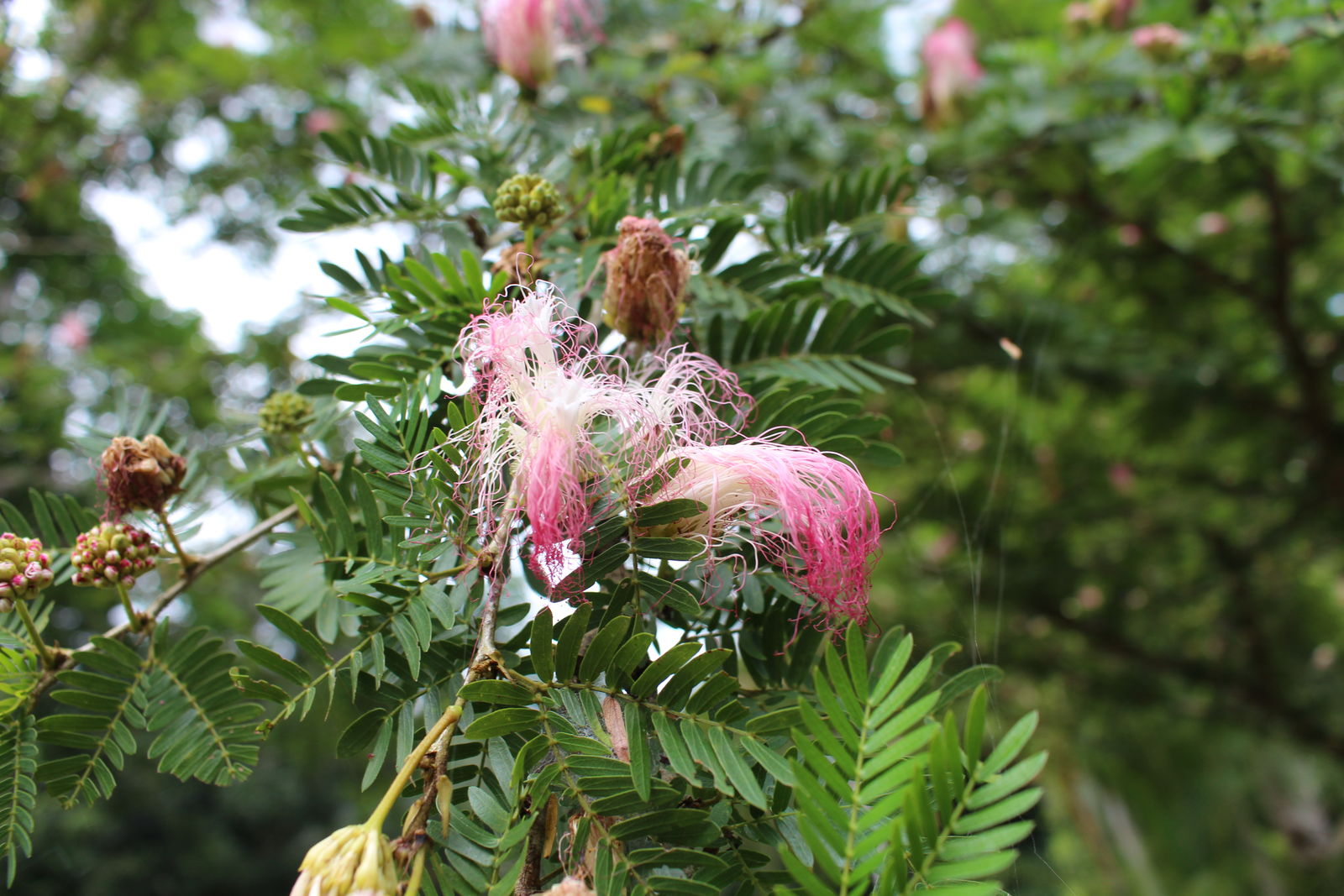Surinam Mimosa
calliandra surinamensis
Also known as: ["Surinam Powder Puff"]
Overview
A tropical shrub with delicate, feathery foliage and distinctive, fluffy, powder-puff-like flowers.
Benefits & Perks
["fragrant flowers","wildlife attractant (bees, butterflies, birds)","aesthetic foliage"]
Botanical Classification
| Phylum: | Magnoliophyta |
| Class: | Magnoliopsida |
| Order: | Fabales |
| Family: | Fabaceae |
| Genus: | Calliandra |
| Botanical Name: | Calliandra surinamensis |
Plant Characteristics
Basic Information
- Category: Flowers
- Suitable Location: outdoor garden in warm, frost-free regions
- Suitable For:
- Is Weed: No
- Allergenicity: low
Environmental Needs
- Climate: {"temperatureRange":"18–35°C"}
- Hardiness: {"zones":"9–11"}
- Misting: every 2–3 days in dry environments
- Drainage: Fast-draining to prevent waterlogging.
- Soil Type: Well-draining potting mix with added perlite or sand for aeration.
Maintenance Level
- Maintenance Level: moderate
- Toughness Level: moderate
- Pruning Frequency: Annually in late winter or early spring before new growth begins.
- Pruning Intensity: Moderate; remove up to one-third of the oldest stems to rejuvenate growth.
Care Details
Ideal Sunlight Coverage:
Bright indirect light for 6–8 hours daily; can tolerate some direct morning sun but avoid harsh afternoon sun.
Sunlight Tolerance Tips:
Acclimate gradually to direct light, protect from intense sun to prevent scorching, adjust placement based on indoor/outdoor conditions.
Care Requirements
Care Difficulty
moderatemoderate
Sunlight
full sun to partial shade
Rotate plant weekly for even growth; use sheer curtains to filter intense light; move outdoors in spring/summer for stronger light.
Watering
every 7–10 days during growing season, reduce in winter
Water thoroughly until it drains from the bottom, allow soil to dry between waterings, avoid overwatering.
Soil
well-draining, sandy loam with organic matter
pH: Slightly acidic to neutral (pH 6.0–7.0).
Use a mix with good drainage; avoid heavy clay soils; top-dress with compost annually.
Temperature
Prefers 65–85°F (18–29°C); tolerates mild fluctuations but avoid prolonged exposure to extremes.
Avoid placing near drafty windows; use a humidifier in dry environments; monitor temperature during seasonal changes.
Fertilizing
every 4–6 weeks during active growth
Fertilize only when actively growing; flush soil occasionally to prevent salt buildup; avoid over-fertilizing.
Propagation
Methods
Stem cuttings in spring/summer.
Step-by-Step Propagation Guide
- Take a 4–6 inch cutting, remove lower leaves, apply rooting hormone, plant in medium, maintain humidity, keep warm.
Best Time: Spring or early summer when the plant is actively growing.
Environment
High humidity (70–90%), warm temperatures (70–80°F), indirect light.
Medium
Well-draining mix of peat and perlite or cactus mix.
Hormone
Recommended to use rooting hormone for faster root development.
Timeline
Roots develop in 4–8 weeks; new growth appears in 2–3 months.
Tools Needed
Pruning shears, rooting hormone, small pots, plastic wrap or propagator.
Quick Tips
Use healthy, non-flowering stems; maintain consistent moisture; provide bottom heat for faster rooting.
Pruning & Repotting
Pruning Guide
Method
Selective thinning and heading back to maintain shape and promote branching.
Pruning Plan
Shape the plant, encourage bushier growth, and remove dead or leggy stems.
Tools
Clean pruning shears, gloves, disinfectant.
Checklist
Disinfect tools, prune dead/leggy stems, shape the plant, clean up debris.
Repotting Guide
Best Season
Spring, when the plant is entering its active growth phase.
Pot Size
One size up (e.g., from 4-inch to 6-inch pot); ensure good drainage.
Method
Remove plant gently, trim roots if needed, place in a slightly larger pot with fresh soil, water lightly.
Suggestions
Repot every 2–3 years or when roots outgrow the pot to refresh soil and provide space.
Checklist
Check root bound status, prepare new pot with drainage, trim roots if necessary, use fresh soil, water lightly after repotting.
Advanced Care Tips
Watering Mastery
Watering Checklist
Check soil moisture, water thoroughly, ensure drainage, adjust for season.
How to Apply Water Properly
Water directly at the root zone, ensure water penetrates deeply, allow excess to drain, water in the morning to reduce evaporation.
Watering Schedule Tips
Water deeply once the top inch of soil feels dry; reduce frequency in winter to prevent root rot.
Soil Improvement
Add perlite or coarse sand for drainage, incorporate organic matter like compost for fertility, ensure good aeration.
Temperature Stress Management
Signs of Temperature Issues
Yellowing leaves, leaf drop, stunted growth, or bud drop.
Cold Stress
Slows growth, causes leaf discoloration, and may lead to root damage if temperatures drop below 50°F (10°C).
Solution: Move to a warmer location, insulate pots, avoid cold drafts, and reduce watering.
Hot Stress
Wilting, leaf scorch, and reduced flowering due to excessive heat and dryness.
Solution: Provide shade, increase humidity, water more frequently, and ensure good air circulation.
Fertilizing Guide
Fertilizing Checklist
Check growth phase, use diluted fertilizer, apply during growing season, flush soil periodically.
Fertilizing Method
Use balanced liquid fertilizer diluted to half strength every 4–6 weeks during growing season (spring/summer); cease in fall/winter.
Common Problems & Solutions
Toxicity Warning
Cats
Slightly ToxicCats may experience mild gastrointestinal irritation if they ingest parts of Calliandra surinamensis. The toxic compounds in the seeds and leaves can cause digestive upset, though severe reactions are rare.
⚠️ Symptoms:
🌿 Toxic Parts:
⚡ Toxic If:
if eaten
Dogs
Slightly ToxicIn dogs, ingestion of Calliandra surinamensis seeds and leaves can lead to mild gastrointestinal upset due to the presence of saponins and other irritants. The effects are generally not life-threatening but can cause discomfort.
⚠️ Symptoms:
🌿 Toxic Parts:
⚡ Toxic If:
if eaten
Humans
Slightly ToxicCalliandra surinamensis contains compounds that can cause mild gastrointestinal distress when ingested. The plant's seeds and leaves are the primary toxic parts, containing saponins and other secondary metabolites that may irritate the digestive tract.
⚠️ Symptoms:
🌿 Toxic Parts:
⚡ Toxic If:
if eaten
Frequently Asked Questions
Q: How often should Calliandra surinamensis be watered?
A: Water moderately, allowing the soil to dry slightly between waterings.
Q: Does Calliandra surinamensis require full sun?
A: Yes, it thrives in full sun to partial shade.
Q: Is Calliandra surinamensis suitable for indoor growing?
A: It is best suited for outdoor cultivation in tropical or subtropical climates.
Quick Reference
| Family: | Fabaceae |
| Care: | moderate |
| Light: | full sun to partial shade |
| Water: | every 7–10 days during growi |
Get Expert Care Tips
Download the Plantious app for personalized care reminders and plant identification!
Google Play App Store








